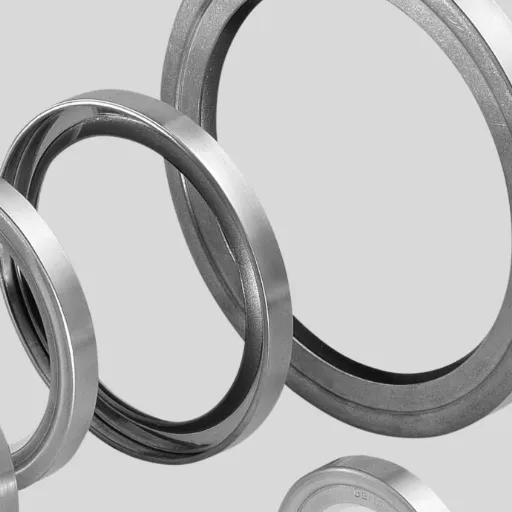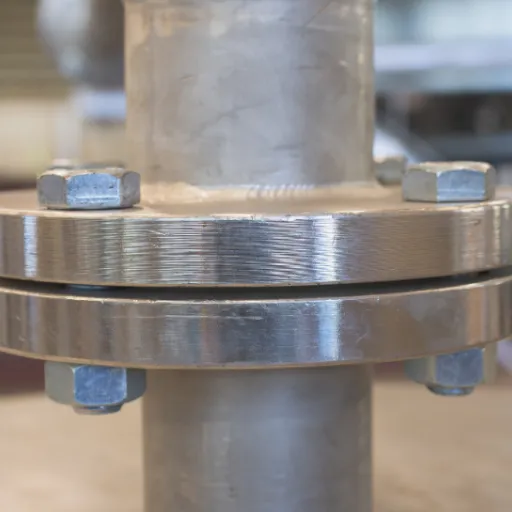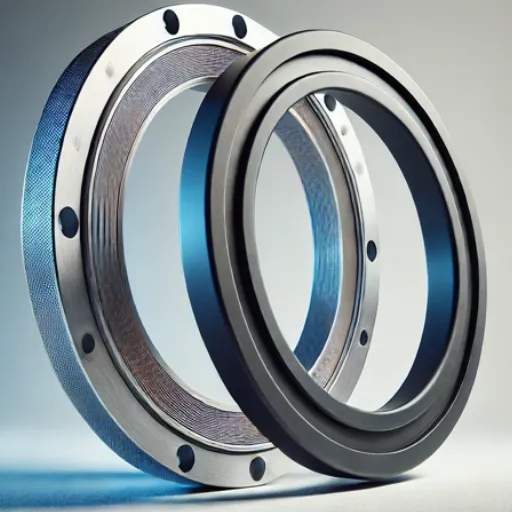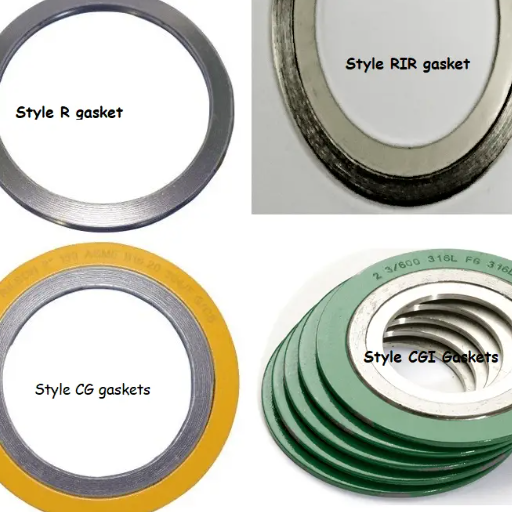Connectors in piping systems play an important role in joining pipes, valves, pumps, and other equipment, and the components must be safe and functional. One of the major issues pertaining to a flange, which also influences its operation and application, is the type of flange face. Among the popular types of flange face are Raised Face (RF) and Flat Face (FF). It is important to understand the difference between the two so one can choose the appropriate flange for their commercial activities. In this article, we’ll weigh the merits of both Raised Face and Flat Face flanges and discuss their common uses to make a thorough comparison to assist the readers in making the correct decision.
Introduction to Flange Face Types

The flange face types being offered are integral to the design of the flange and exert influence on its performance and interfacing in various industrial applications. In the case of the Raised Face (RF), the flange has a slightly raised surface around the bore opening to concentrate the pressure during tightening on the gasket, hence enhancing sealing action. Such a type of design is best suited for high-pressure applications. However, the Flat Face (FF) flange presents a smooth full mating surface, which it can be used in low-pressure applications and with cast iron equipment to prevent damage. Knowing the distinctions between these flange face types permits selection for safety, efficiency, and longevity in various applications.
What is a Flange?
It is a mechanical fitting that joins together pipes, valves, equipment for pumping, and an assortment of configurations within piping systems, providing strength and sealing capabilities to the installations. It offers a solid joint that lends itself well to being easily assembled, disassembled, or maintained as needed while providing for a leakage-proof seal when used with a gasket and when properly tightened. Flanges come in different varieties with designs specific to the requirements of pressure, temperature, and materials, otherwise useful in sectors such as oil and gas, chemicals, or water treatment.
Importance of Flange Face Types
The importance of flange face types cannot be emphasized enough, since it directly affects the sealing performance and suitability for a given application. Different flange face types (such as raised face, flat face, ring-type joint) are designed for different pressure levels, temperature ranges, and gasket materials. For example, raised face flanges are used in high-pressure systems where there’s a need for better sealing; on the other hand, flat face flanges are used in low-pressure systems so as to avoid stress on the connected components. With the right choice, you are assured of efficient seal and long-term serviceability against leakage and failure of the system; hence, it is necessary to know the basic differences that could affect optimal performance in mechanical systems so that you select the right one.
Overview of RF and FF Flanges
Knowledge of the unique RF and FF applications is crucial. Raised face flanges, for instance, are best suited for systems that operate under high pressure, as they allow exertion of pressure over a relatively smaller gasket area for enhanced sealing. Thus, any situation demanding a near-perfect seal to prevent any chance of leakage would prefer this particular type. Flat face flanges, conversely, find their place in low-pressure service, where the objective is to foster an even distribution of stress across the flange surface so as not to cause damage to the linked components. In picking between the two, considering pressure requirement and system demand would guarantee a more functional and less maintenance-intensive setup.
Raised Face Flange (RF)

The intention of Raised Face (RF) flanges is to ensure that pressure is exerted on the sealing surface to enhance gasket containment of higher pressures. This is done with a somewhat raised surface around the bore of the flange, where the gasket settles on. RF flanges work best under high-pressure and high-temperature working conditions. The raised surface provides better compression of the gasket, which enhances sealing. Industries such as oil and gas, chemical processing, and power generation are some of the fields which commonly employ RF flanges, owing to their strong nature and ability to withstand any leak whatsoever under extreme conditions. Considering their versatility, they are often the go-to when system reliability and sealing efficiency are prioritized.
Definition and Characteristics
Raised face flange, known as an RF flange, is a kind of pipe flange with a slightly raised surface around the bore to improve sealing performance. By having such a surface, the gasket can be compressed much better during tightening, thereby reducing the risk of leakage during high-pressure and high-temperature conditions. This type of flange is normally made from materials with great durability, hence why they are held to be strong and dependable. RF flanges, therefore, have an extensive industrial application, such as oil and gas, where system integrity and efficiency are of utmost importance. They have adaptable designs, making them the best alternative to pipeline systems requiring excellent sealing capacity and performance over a long period of time in harsh working environments.
Common Applications of Raised Face Flanges
Raised Face flanges find usage in a diverse range of industrial situations because of their versatility and good performance. Specially, the domain of oil and gas processing is one in which it is of the utmost importance to have a secure seal which can withstand great pressures and high temperatures. Beyond this, they serve a prominent role in chemical processing plants, preserving integrity in systems that deal with corrosive or hazardous substances. Furthermore, power generation plants also provide for situations whereby high stresses exist in steam and gas pipelines, where these flanges provide effective service. Their durability and adaptability grant them speculated status within the companies of piping in many industries.
Gasket Considerations for RF Flanges
While selecting gaskets for RF flanges, one should consider operating conditions, pressure, temperature, and chemical compatibility of all involved materials. According to my findings, non-metallic gaskets like rubber or PTFE are fine for low-pressure applications, while metallic or semi-metallic gaskets, such as spiral-wound gasket types, are suitable for high-pressure and high-temperature conditions. The surface finish of the flange is also important, as sealing depends on it; rougher finishes tend to need softer gaskets for proper sealing. Great standards such as ASME or API would assist in ensuring compatibility and correct functioning of the gasket. Remember, choosing the right gasket enhances your system efficiency and anytime reduced possibility for leaks and maintenance downtime.
Flat Face Flange (FF)

Flat Face Flanges (FF) are constructed with a completely flat surface for sealing, thus being apt for low-pressure applications. These flanges are always used in conjunction with full-face gaskets to ensure uniform contact and to avoid any uneven stresses which could diminish the sealing. They are mostly used in systems made of cast iron or other materials that are susceptible to brittle failure, while a flat face lowers the risk of stress concentration. When considering or selecting a flat face flange, it is important to think about the operating pressure, temperature, and type of materials that may come in contact with the flange or the connected components for the best and most reliable performance.
Definition and Characteristics
Flat face flanges, in essence, are flanges with a flat sealing surface. This flat junction ensures uniform contact with rubbers or other gasket materials. This surface will not concentrate stress and is most compatible with systems constituted by brittle materials, like cast iron, where uneven stress could occasion bearing failure. I usually factor in flat face flange selection some of the operating pressures and temperatures for which the flat face flange will be used in the application, while considering material compatibility with the connected components of the system. These factors are vital to ensure that the system will stand the test of time in terms of performance, safety, and dependability.
Common Applications of Flat Face Flanges
The flat face flanges usually find application in systems operating under low pressure where the piping connections are required to be rigid. I find them often in the water treatment and drainage industries, as well as in HVAC where the maintenance of alignment at lower pressure is a virtue. Flat face flanges may also be a preferred choice for systems in non-metallic piping, like PVC or fiberglass, where stress on pipe materials can be avoided. Maintaining a smooth full surface seal, these flanges stand out in clear and consistent leak-prevention applications, especially while maintaining system integrity under given operating conditions.
Gasket Considerations for FF Flanges
When choosing gaskets for FF (Full-Face) flanges, it is crucial to ensure that it is compatible with the piping material and the system requirements. Usually, non-metallic gaskets, such as rubber, PTFE, or compressed fiber, are employed for these types of flanges because they can make a complete, full seal. Due to the wide sealing surface of FF flanges, it is necessary that the gaskets be capable of evenly distributing pressure and compensating for minor surface irregularities.
Temperature, pressure, and chemical compatibility must also be considered to ensure that the gasket material can handle the expected operating conditions of your particular system. Correct installation practices, such as carefully tightening bolts using a cross-pattern, will guarantee a leak-tight seal; otherwise, sealing and potential damage to the piping or gasket will occur. Selecting the correct gasket materials and using best practices to install them will provide long-term reliability and efficiency for piping systems with FF flanges.
Raised Face vs. Flat Face: Key Differences

|
Parameter |
Raised Face (RF) |
Flat Face (FF) |
|---|---|---|
|
Surface |
Raised |
Flat |
|
Pressure |
High |
Low |
|
Temperature |
High |
Low |
|
Gasket |
Spiral/Metal |
Full-face |
|
Material |
Steel/Alloy |
Cast Iron |
|
Applications |
Oil/Gas, Power |
Water, Plumbing |
|
Leak Prevention |
Strong |
Moderate |
|
Cost |
Higher |
Lower |
Comparison of Flange Face Types
If I were to say the major difference between RF and FF flanges, I would say the utmost difference must remain in their design and application. Systems subjected to higher pressures opt for the RF flange as the raised face allows for better sealing with the gasket to prevent leakage. In contrast, the FF flange finds use in low-pressure applications where materials that are very sensitive to stress, such as cast iron, are used; the flat surface will ensure that the gasket does not generate excessive stresses on such brittle components. Thus, the choice of RF or FF flanges would depend upon pressure levels, compatibility with materials, and requirements of the piping system in question.
When to Use Raised Face vs. Flat Face Flanges
One of the most elemental decisions as far as the application of flanges is concerned shall be decided on whether the raised face (RF) or the flat face (FF) type of flange is suitable. Factors considered will include pressure ratings, material compatibility, application-specific requirements, and industry standards. According to data available from search trends and information from authoritative sources, raised face flanges are mostly used in systems with moderate and high pressure. This raised sealing surface allows good compression of the gasket to maximize the prevention of leakage in refineries, chemical plants, and power generation facilities.
On the other hand, flat face flanges shall be recommended for applications under low pressure and in systems working with brittle or non-ductile materials such as cast iron, as the flat face either generally reduces the possibility of crack propagation or would not overburden the partner components. The HVAC and water distribution sectors are those where stress-reduction is preferred for flat face flanges.
Knowing the difference and exploiting, however, the operational condition best, will certainly keep good system integrity, reduce maintenance, and overall improvement in safety. Along with this information, engineers and designers are well equipped for decision-making with diagrams and technical specifications sourced from trusted online sites.
Impact on Sealing and Performance
In sealing and performance, a good choice of flange types becomes very crucial. For instance, the raised face flange provides better sealing when higher pressure and temperature operate on the flat surface, which allows better gasket compression, minimizing leakage in arduous applications. Contrary to this, the flat face flange may be favored in low-pressure operations where one expects flat contact with the kind of material like non-metallic gasketing, hence good stress distribution. By a thorough evaluation of the operating conditions and juxtaposing a suitable flange to the actual application requirements, I can hencekey optimize sealing integrity plus overall efficiency of the system.
Common Types of Flange Faces

|
Key Point |
Flat Face (FF) |
Raised Face (RF) |
Ring-Type Joint (RTJ) |
|---|---|---|---|
|
Sealing Area |
Large |
Medium |
Small |
|
Pressure Range |
Low |
Broad |
High |
|
Temp. Range |
Low |
Broad |
High |
|
Gasket Type |
Soft |
Semi-metallic |
Hard |
|
Applications |
Low-pressure |
General |
High-pressure |
Overview of Flange Face Types
Selecting a flange face type is vital if an operation wants sealing performance under standard conditions for air, water, or other gaseous fluids. Common types are Raised Face (RF), Flat Face (FF), Ring-Type Joint (RTJ), and Male-Female (M/F) arrangements.
Raised Face (RF): In industrial applications, RF flange is the most commonly used design. Its raised surface around the bore places more pressure on the gasket, increasing the sealing performance in environments of extreme temperatures and pressure. In the oil, gas, and chemical industries, this type is in high demand.
Flat Face (FF): FF flanges are flat, having an even surface apt for lower-pressure and lower-temperature applications. They are typically setup with full-face gaskets that maintain even pressure over the sealing surface. These flanges dominate water treatment plants, ductile iron pipelines, and other non-metallic gasket set.
Ring Type Joint (RTJ): RTJ flanges are used in the more extreme conditions, including very high-pressure and temperature systems. Their metal ring is fitted into a machined groove on the flange face, creating a metal-to-metal seal. They find their way into petroleum refineries, offshore platforms, and high-pressure systems.
Male-Female (M/F): It is a matching pair of male and female faces where the raised Male portion fits into the recessed Female area. These are used when exact alignments and enhanced seals against leakage are required, such as in chemical plants.
Having understood the nature and use of the different flange face types, the industry can, therefore, select a good and suitable sealing system that meets the demands of actual operations.
Advantages and Disadvantages of Each Type
Flat Face Flanges:
Advantages: Simple design, economic, and installation can be easy for low-pressure applications.
Disadvantages: The flat face cannot seal efficiently if subjected to some pressure and temperature.
Raised Face Flanges:
Advantages: A raised face concentrates the areas of the gasket subjected to pressure, enhancing sealing capability. This type of flange finds a variety of uses.
Disadvantages: Slightly more costly and may need careful handling and storage to avoid damage to the raised face during installation.
Ring-Type Joint (RTJ) Flanges:
Advantages: The best sealing under pressure and high temperature for critical applications in the oil and gas industry.
Disadvantages: Costs more, requires precise alignment, and usually cannot be reused after dismantling.
Tongue-and-Groove Flanges:
Advantages: It gives excellent alignment and sealing with better resistance against leaks, suited for applications involving hazardous materials.
Disadvantages: High manufacturing cost, and have marginal interchangeability due to their unique tongue-and-groove fittings.
Choosing the Right Flange Face for Your Application
When deciding upon the correct flange face for my application, I still proceed with considering the specific working conditions occurring; for example, the fluid treated or handled within, pressures within, and temperature ranges. If a perfect seal had to be obtained for high pressure, I may have considered the ring-type joint (RTJ) flange. For the general one, there is no need for special consideration as the raised face flange may do. There is also a consideration of the chance that it may leak, difficulty in maintenance, and compatibility with existing equipment, while making sure that the flange face chosen meets both safety and performance standards.
Reference Sources
- Ohio State University (OSU): Discusses raised face blind flanges and their sealing capabilities. Link to source1.
- Western Michigan University (WMU) Design Guidelines: Provides details on full-face and narrow-face types for flat-face and raised-face flanges. Link to source2.
- University of Minnesota Conservancy: Explains full-face and narrow-face types for flat-face and raised-face flanges. Link to source
- Top Blind Flanges Suppliers in China
Frequently Asked Questions (FAQs)
What is the difference between raised face flanges and flat face flanges?
The difference between raised face flanges and flat face flanges primarily lies in their design and application. A raised face flange features a raised area around its circumference, which helps to concentrate the gasket pressure on the sealing surface, improving the seal between the mating flange or flanged fitting. In contrast, flat face flanges are completely flat, designed to be used with full face gaskets to ensure an even distribution of pressure across the entire face. This makes flat face connections ideal for applications where the flanges are made of dissimilar materials, such as carbon steel and cast iron flanges. Additionally, the height of the raised face is an important specification, particularly in high-pressure systems where sealing integrity is critical. Ultimately, the choice between these two types of flange faces depends on the specific requirements of the piping system and the flange material used.
What are the common types of flange faces used in piping systems?
In piping systems, the common types of flange faces include raised face, flat face, and ring-type joint (RTJ) flanges. Raised face flanges are often used in high-pressure applications due to their ability to concentrate gasket pressure, while flat face flanges are typically used in low-pressure systems, especially when connecting to cast iron flanges or in situations where the piping materials differ. The RTJ flanges are designed with grooves that accommodate a ring gasket, providing a reliable seal in high-pressure environments. Each type of flange face has its specific applications and is chosen based on factors such as the flange diameter, material compatibility, and the desired sealing method. Understanding these common types of flange faces can help in selecting the right flange for any piping project.
How does the face type of a flange affect its performance?
The face type of a flange significantly impacts its performance, particularly in terms of sealing capabilities and pressure retention. For instance, raised face flanges are designed to have a raised area that enhances the contact pressure on the gasket, ensuring a more robust seal, especially in high-temperature and high-pressure scenarios. On the other hand, flat face flanges provide a broader sealing surface for full face gaskets, which can be beneficial when connecting different materials, as it minimizes stress concentrations. The choice of flange face type also influences the bolting circle where the gasket is placed, which can affect the overall integrity of the flange connection. Additionally, the correct flange face type must be matched with the appropriate flange material to ensure compatibility and durability over time.
What materials are commonly used for flat face and raised face flanges?
Common flange materials for both flat face and raised face flanges include carbon steel, stainless steel, and cast iron. Carbon steel flanges are widely used due to their strength and cost-effectiveness, making them suitable for various applications. Stainless steel flanges are preferred in corrosive environments because of their resistance to oxidation and rust. Cast iron flanges, often used in low-pressure systems, offer good durability but may not be suitable for high-stress applications. The choice of flange material is essential, as it affects the performance under different operational conditions, such as temperature and pressure. Furthermore, the flange protection during storage and transport is crucial to maintain the integrity of the flange material until installation.
What is the purpose of the raised area in a raised face flange?
The purpose of the raised area in a raised face flange is to concentrate the gasket pressure around the sealing surface, enhancing the sealing capability of the flange connection. This raised surface above the bolting circle allows for a tighter seal, making it particularly effective in high-pressure applications. The raised face height varies depending on the flange specifications, such as ASME B16.5, which dictates the dimensions and tolerances for various flange types. By providing a smaller contact area for the gasket, the raised face can help to prevent leaks and maintain integrity in the joint flanges. Understanding this feature is vital for engineers and technicians when designing and selecting flanges for their piping systems, as it ensures optimal performance and reliability.






